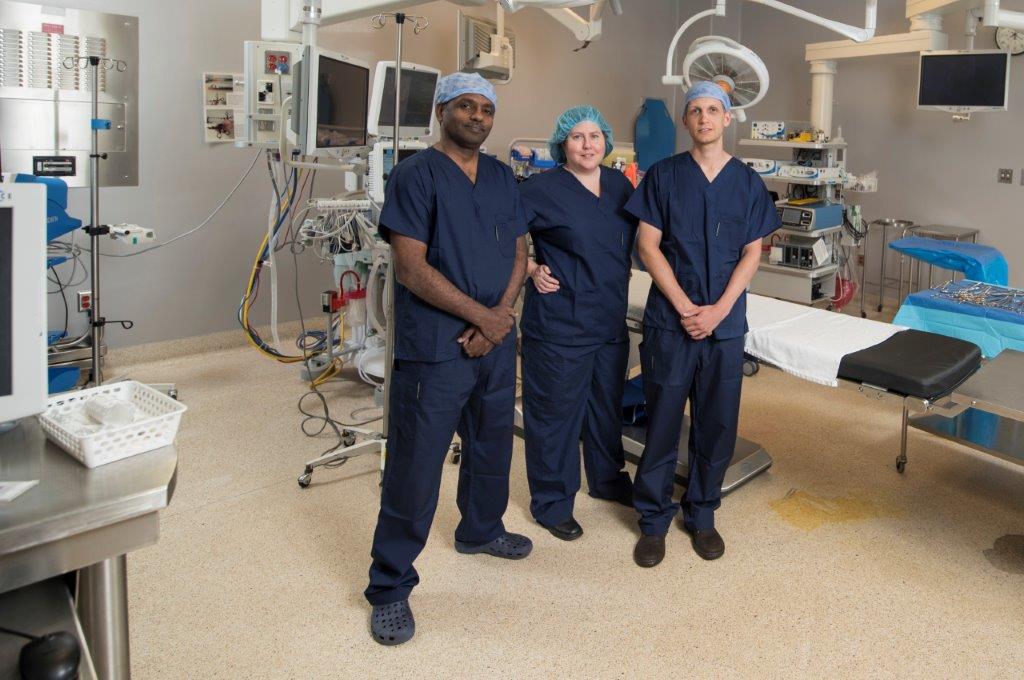Vascular Surgery Program Already a Success at Our Hospital
Published Monday, August 30, 2021

The three vascular surgeons at Thunder Bay Regional Health Sciences Centre have been hard at work saving life and limb. Pictured in this 2019 photo are Dr. Elrasheed Osman, Dr. Mary MacDonald, and Dr. Matthew Ingves.
Most of us don’t understand what vascular surgery involves or how vitally important it is to healthcare. “An apple a day keeps the doctor away” – that’s an easy concept. But vascular surgery? What does that even mean?
Here’s one example of how important it is. The amputation rate in Northwestern Ontario was three times higher than the rest of the province. Three times! There are different reasons for amputation, but one of them is poor circulation due to diabetes and other health conditions. Lack of blood flow slowly kills the tissue in the limb, most commonly the leg. Eventually, the leg simply dies. The tragedy is, this type of amputation is often preventable thanks to the help of – you guessed it – vascular surgeons.
Vascular surgeons can help improve circulation in a variety of ways and avoid amputation. But with these services a day’s drive or more away from Thunder Bay, our patients simply didn’t have access to them. Some patients when given the choice to travel for health services chose amputation instead to avoid the costs, stress, and difficulties of leaving home for care.
That’s a choice no one should ever have to make.
Thankfully, that is changing. The Thunder Bay Regional Health Sciences Centre now has a full staff of three vascular surgeons: Dr. Mary MacDonald, Dr. Elrasheed Osman, and Dr. Matthew Ingves, who was born and raised in Thunder Bay. They have helped improve healthcare in our region in so many other ways, too.
Take emergency endovascular aneurysm repair or EVAR, for example. This minimally invasive procedure fixes an abdominal aortic aneurysm (AAA) or bulging of the aorta, the body’s largest blood vessel. Sometimes the aorta can bulge so far that it ruptures, leading to internal bleeding and a high risk of death.
Traditionally, surgeons would make a large incision in the abdomen to repair it. But EVAR avoids all that. Doctors can reach the site of the aneurysm by following the blood vessels up through a small incision in each leg. Then, they place a stent to strengthen the weak spot in the aorta, much like angioplasty.
The repair is basically the same whether you use EVAR or traditional surgery, but EVAR is much less traumatic for the patient. It also leads to a shorter recovery time, less pain, less risk of infection, and less risk of many other side effects.
Trauma is another area where vascular surgeons really help. Car accidents, crushing injuries, power tool mishaps, and other accidents that result in severed arteries can cause internal bleeding and loss of blood circulation. Previously, general surgeons in our Emergency Department would repair what they could and send the patient on to a vascular surgeon in southern Ontario.
But every second counts in these situations, and travelling long distances with severe injuries adds to the risks. Thankfully, our patients can now get the vascular surgery they need faster, safer, and without the need for travel.
These are just a few of the ways vascular surgeons help patients every day. Of course, that’s the goal of the whole Cardiovascular Surgical (CVS) program and the Our Hearts at Home Cardiovascular Campaign: to provide better and faster access to the cardiovascular surgical services we need, right here in Thunder Bay.
We all deserve closer-to-home care. Thanks to the Our Hearts at Home Cardiovascular Campaign, we will build on the successes of vascular surgery to create a full CVS program including cardiac surgery. You can help! Please give at healthsciencesfoundation.ca/donatenow or call our Donation Centre at (807) 345-4673.